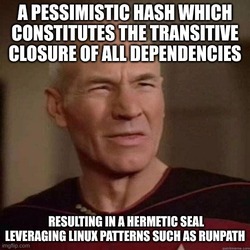Learn Nix the Fun Way
Published 2024-07-05 on Farid Zakaria's Blog
This is a post inspired by many talks I’ve given to engineering groups about Nix. You can see an example of one such talk Why I love Nix, and you should too
I’ve given a lot of Nix talks. I’ve given Nix talks internally at companies where I’ve introduced it, at local meetups and even at NixCon.
Giving a talk about Nix is hard. As engineers I find often we try to explain why or how Nix works but never show the end result.
Many of the talks I’ve given start explaining “Nix developed as part of Eelco’s PhD thesis in 2003” and immediately eyes roll.

Let’s do it different this time. Let’s learn Nix the fun way.
what-is-my-ip
Let’s walk through a single example of a shell script one may write: what-is-my-ip
#! /usr/bin/env bash
curl -s http://httpbin.org/get | \
jq --raw-output .origin
Sure, it’s sort of portable, if you tell the person running it to have curl and jq. What if you relied on a specific version of either though?
Nix guarantees portability.
We might leverage Nixpkgs’ trivial builders to turn this into a Nix derivation (i.e. build recipe).
{
pkgs ? import (fetchTarball "https://github.com/NixOS/nixpkgs/archive/nixos-24.05.tar.gz") { },
}:
pkgs.writeShellScriptBin "what-is-my-ip" ''
${pkgs.curl}/bin/curl -s http://httpbin.org/get | \
${pkgs.jq}/bin/jq --raw-output .origin
''
😬 Avoid over-focusing on the fact I just introduced a new language. Just come along for the ride.
Here we are pinning our package to dependencies which come from NixOS/Nixpkgs release branch 24.05.
If we build this, we get the result:
/nix/store/lr6wlz2652r35rwzc79samg77l6iqmii-what-is-my-ip
❯ /nix/store/lr6wlz2652r35rwzc79samg77l6iqmii-what-is-my-ip/bin/what-is-my-ip
24.5.113.148
Now that this is in Nix and we’ve modeled our dependencies, we can do fun things like generate graph diagrams to view them (click the image to view larger).
❯ nix-store --query --graph $(nix-build what-is-my-ip.nix) | \
dot -Tpng -o what-is-my-ip-deps.png
Let’s create a developer environment and bring in our new tool. This is a great way to create developer environment with reproducible tools
let
pkgs = import (fetchTarball "https://github.com/NixOS/nixpkgs/archive/nixos-24.05.tar.gz") {};
what-is-my-ip = import ./what-is-my-ip.nix {inherit pkgs;};
in
pkgs.mkShell {
packages = [what-is-my-ip];
shellHook = ''
echo "Hello, Nix!"
'';
}
❯ nix-shell what-is-my-ip-shell.nix
Hello, Nix!
[nix-shell:~/tutorial]$ which what-is-my-ip
/nix/store/lr6wlz2652r35rwzc79samg77l6iqmii-what-is-my-ip/bin/what-is-my-ip
🕵️ Notice that the hash lr6wlz2652r35rwzc79samg77l6iqmii is exactly the same which we built earlier.
We can now do binary or source deployments 🚀🛠️📦 since we know the full dependency closure of our tool. We simply copy the necessary /nix/store paths to another machine with Nix installed.
❯ nix copy --to ssh://nixie.tail9f4b5.ts.net \
$(nix-build what-is-my-ip.nix) --no-check-sigs
❯ ssh nixie.tail9f4b5.ts.net
[fmzakari@nixie:~]$ /nix/store/lr6wlz2652r35rwzc79samg77l6iqmii-what-is-my-ip/bin/what-is-my-ip
98.147.178.19
Maybe though you are stuck with Kubernetes or Docker. Let’s use Nix to create an OCI compatible image.
let
pkgs = import (fetchTarball "https://github.com/NixOS/nixpkgs/archive/nixos-24.05.tar.gz") {};
what-is-my-ip = import ./what-is-my-ip.nix {inherit pkgs;};
in
pkgs.dockerTools.buildImage {
name = "what-is-my-ip-docker";
config = {
Cmd = ["${what-is-my-ip}/bin/what-is-my-ip"];
};
}
❯ docker load < $(nix-build what-is-my-ip-docker.nix)
Loaded image: what-is-my-ip-docker:c9g6x30invdq1bjfah3w1aw5w52vkdfn
❯ docker run -it what-is-my-ip-docker:c9g6x30invdq1bjfah3w1aw5w52vkdfn
24.5.113.148
Cool! Nix + Docker integration perfectly. The image produced has only the files exactly necessary to run the tool provided, effectively distroless.
Finally, let’s take the last step and create a reproducible operating system using NixOS to contain only the programs we want.
let
nixpkgs = fetchTarball "https://github.com/NixOS/nixpkgs/archive/nixos-24.05.tar.gz";
pkgs = import nixpkgs {};
what-is-my-ip = import ./what-is-my-ip.nix {inherit pkgs;};
nixos = import "${nixpkgs}/nixos" {
configuration = {
users.users.alice = {
isNormalUser = true;
# enable sudo
extraGroups = ["wheel"];
packages = [
what-is-my-ip
];
initialPassword = "swordfish";
};
system.stateVersion = "24.05";
};
};
in
nixos.vm
❯ nix-build what-is-my-ip-vm.nix
❯ QEMU_KERNEL_PARAMS=console=ttyS0 ./result/bin/run-nixos-vm -nographic; reset
<<< Welcome to NixOS 24.05pre-git (x86_64) - ttyS0 >>>
Run 'nixos-help' for the NixOS manual.
nixos login: alice
Password:
[alice@nixos:~]$ which what-is-my-ip
/etc/profiles/per-user/alice/bin/what-is-my-ip
[alice@nixos:~]$ readlink $(which what-is-my-ip)
/nix/store/lr6wlz2652r35rwzc79samg77l6iqmii-what-is-my-ip/bin/what-is-my-ip
[alice@nixos:~]$ what-is-my-ip
24.5.113.148
💥 Hash lr6wlz2652r35rwzc79samg77l6iqmii present again!
We took a relatively simple script through a variety of applications in the Nix ecosystem: build recipe, shell, docker image and finally NixOS VM.
Hopefully, seeing the fun things you can do with Nix might inspire you to push through the hard parts.
There is a golden pot 💰 at the end of this rainbow 🌈 awaiting you.
Learn Nix the fun way.
Improve this page @ 89107ef
The content for this site is
CC-BY-SA.
